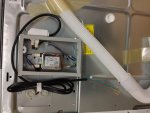- Location
- Lockport, IL
- Occupation
- Semi-Retired Electrical Engineer
We all know that the manufacturers of dryers don?t include the power cord with the machine, because they can?t know which type of outlet any given home will have. I have a project in a US military base overseas. The outlets are not US standard, but we are providing US-made dryers. The manufacturer declined to provide power cords with the appropriate cord caps for the project location. I have been asked whether it would be acceptable to take a US-standard power cord, cut off the cord cap, and install a cord cap of the proper type.
I don?t have a problem with the concept. What I don?t know is whether the power cord is likely to have its own UL listing, and whether altering the cord would invalidate that listing. But even if those answers are yes and yes, I am not certain whether that would be a problem. Any thoughts?
I don?t have a problem with the concept. What I don?t know is whether the power cord is likely to have its own UL listing, and whether altering the cord would invalidate that listing. But even if those answers are yes and yes, I am not certain whether that would be a problem. Any thoughts?


